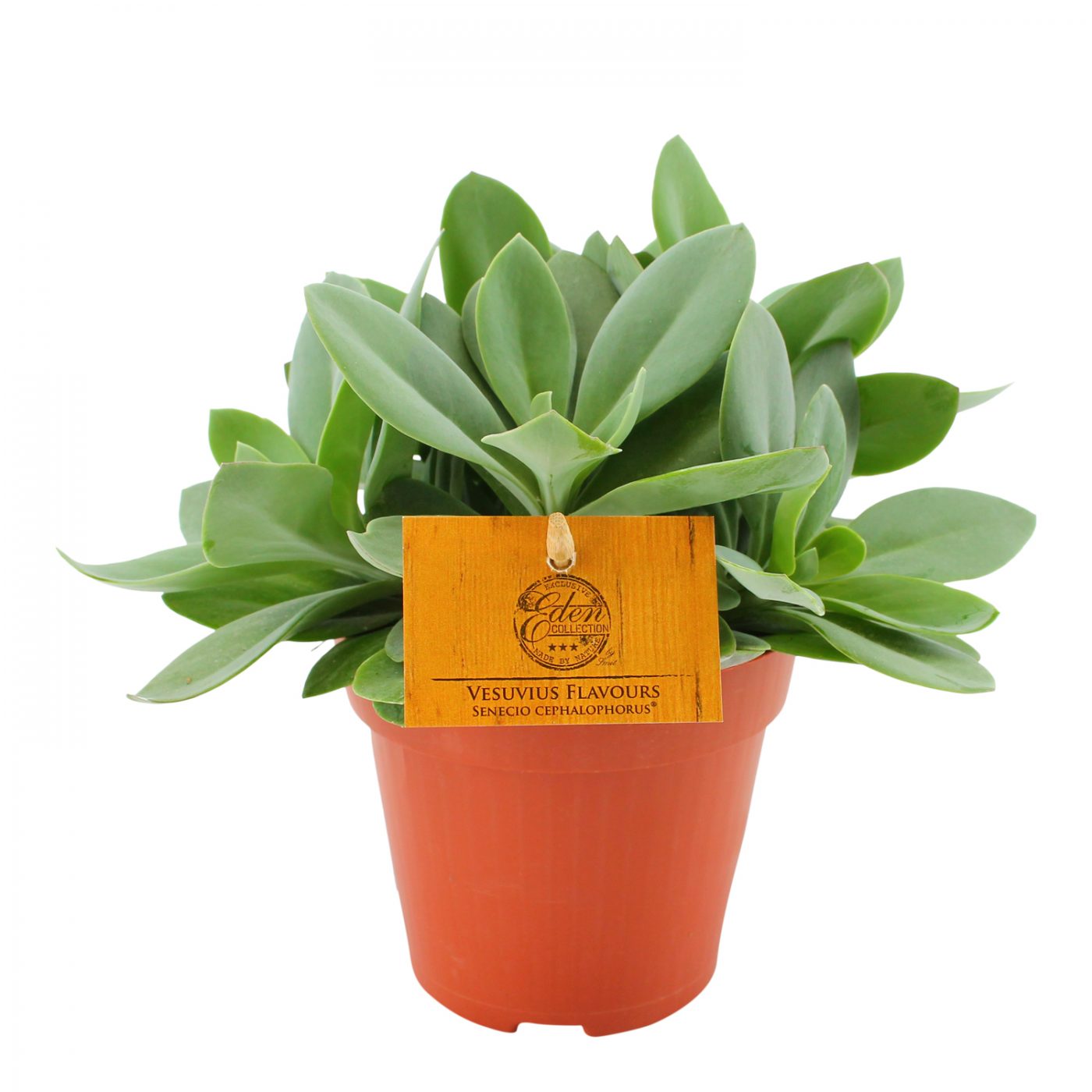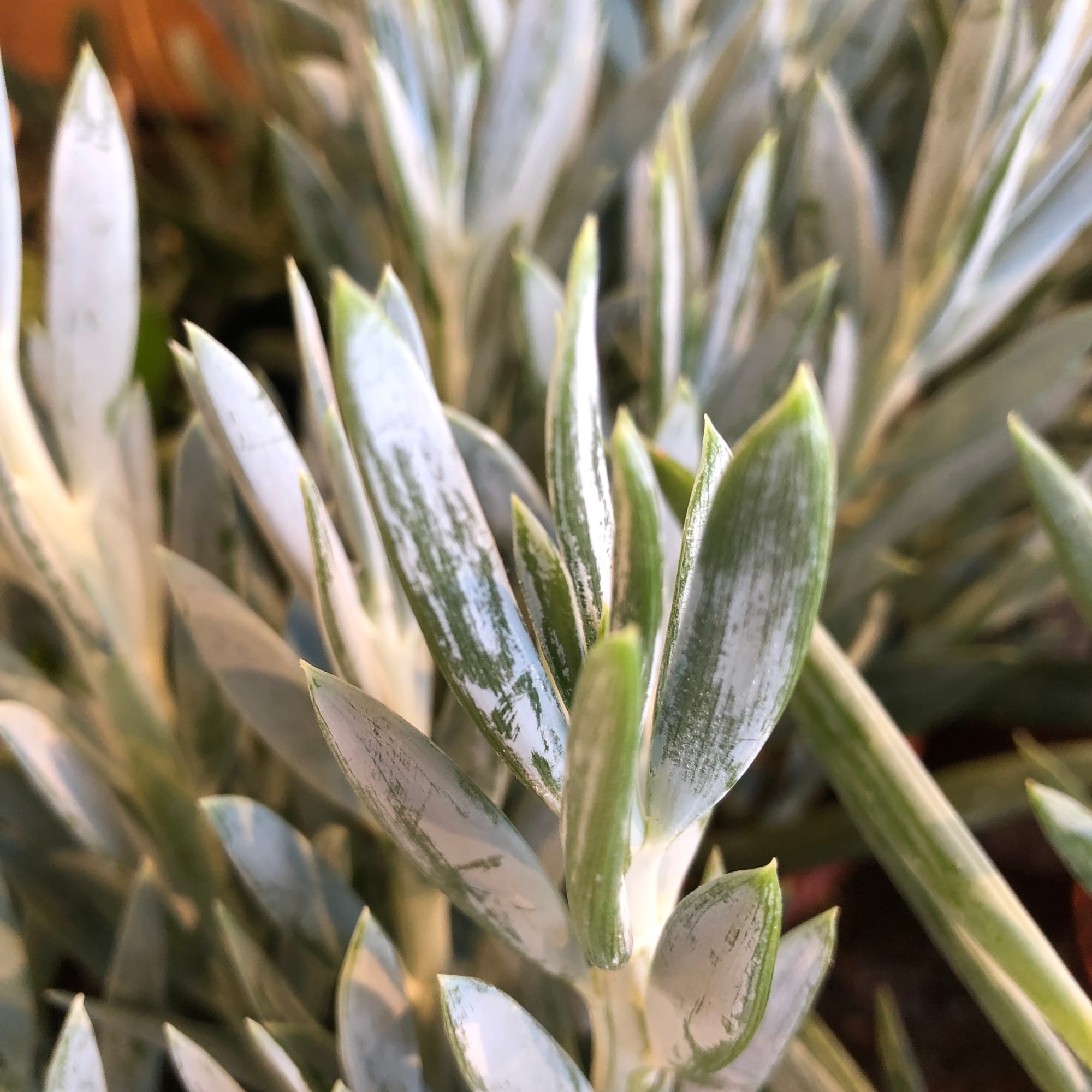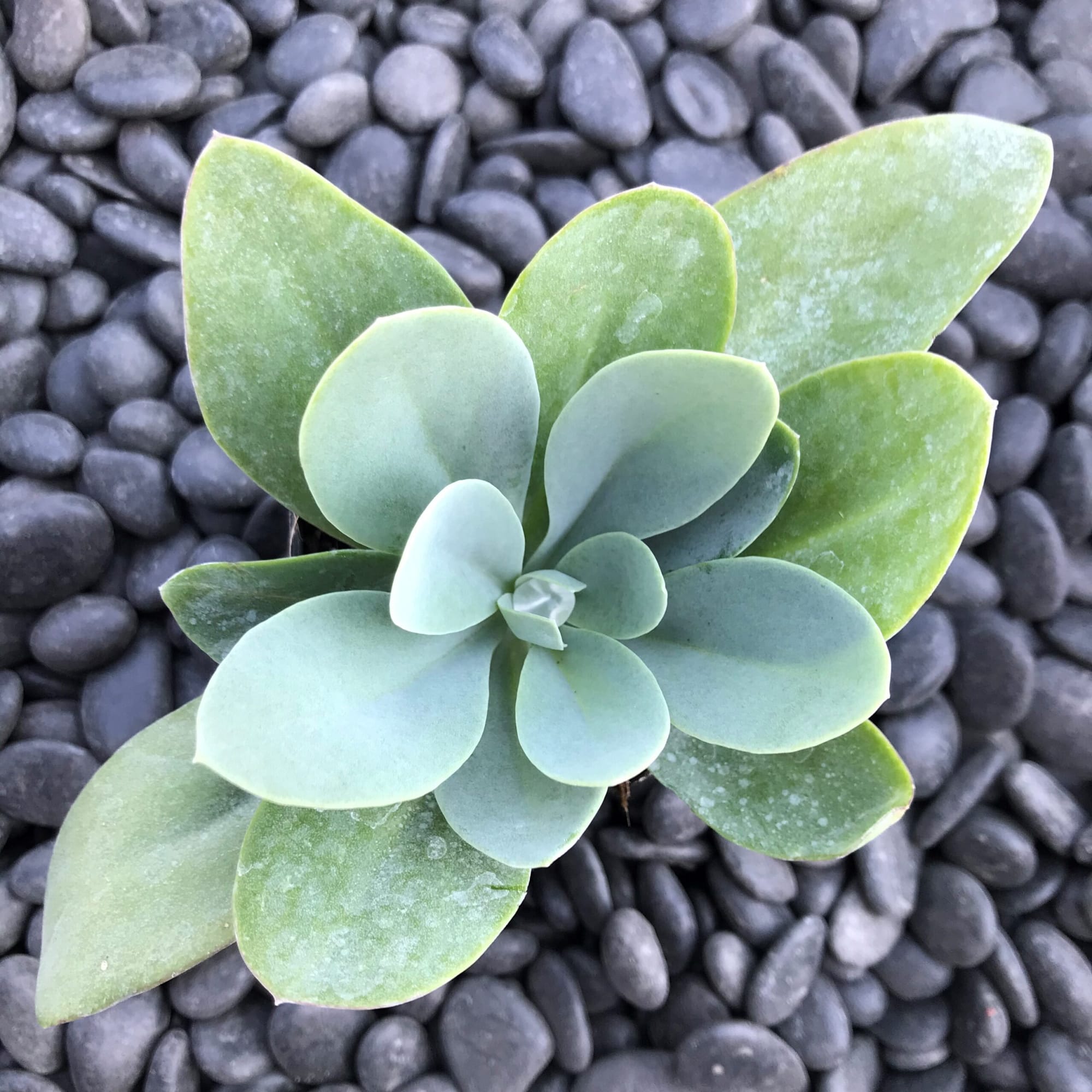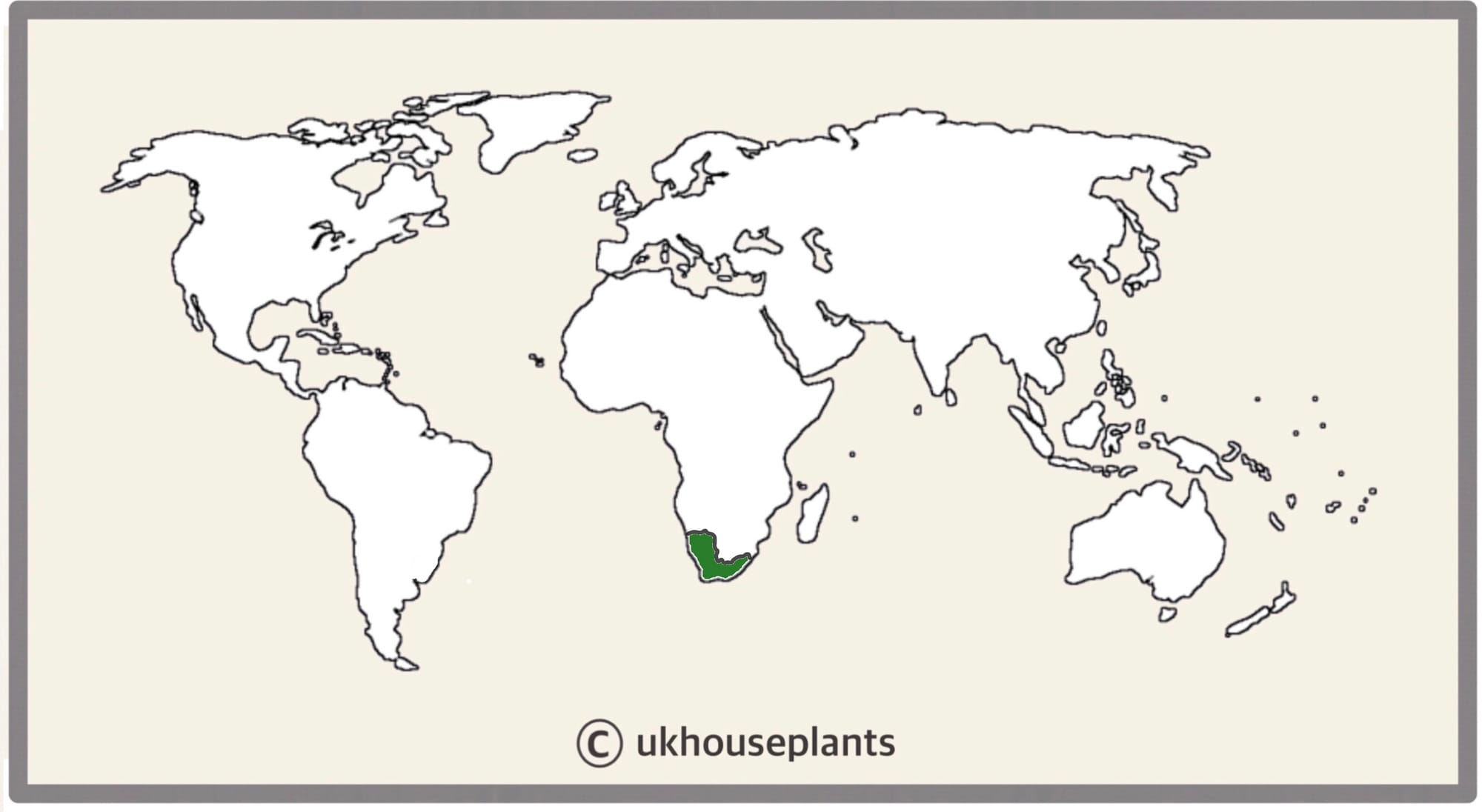
Kleinia cephalophora 'Fuji'. Copyright: Eden Collection. (Originally known as Senecio until the 1960's).
Contents
- Top Tips
- Location, Water, Humidity & Fertilisation
- Common Issues
- Origins, Temperature, Propagation, Repotting & Toxicity.
Need the answer to a specific plant query? Book a 1-to-1 video call with Joe Bagley, the website's friendly author, to overcome and address your niggling problem! Available on iMessage, WhatsApp, Facebook Messenger & more.
Top Tips & Info
- Care Difficulty - Very Easy
- Provide a bright location with no more than a few hours of sunlight per day, especially in the height of summer - shady areas must be avoided at all costs, so somewhere between partial-sun to 'bright, indirect light' is acceptable.
- It's best to allow the soil's majority to dry out in between hydrations, as basal rot is a key issue among gardeners - we'd recommend watering the plant once every ten days or so.
- Fertilise using a 'Houseplant' labelled feed every four waters in the spring and summer, reducing this to every six in the colder months.
- Repot every two years during the spring, using a 'Cactus & Succulent' labelled potting mix. Although you can use a 'Houseplant' compost, the good ability at water-retention may lead to root rot if your specimen is located in a shadier spot with periods of soggy soil.
- This species is generally pest-free. Have a good look for Mealybugs for the first month after purchase, as the best way to organise an infestation is by bringing new plants.
Location & Light - 🔸🔸🔸
Perfecting the amount of light a Senecio cephalophorus receives is crucial for a long-lasting specimen. During the spring and summer, be sure to provide a brightly lit spot away from any direct light. Excessive exposure during this time will negatively affect the plant in the likes of sun-scorch and dehydration. Once the autumn kicks in, be sure to include an hour or two of direct light per day to get it through the dormancy period, lasting until the following spring. Due to the species' intolerance to low light, avoid placing one in areas where a newspaper can’t be read without the use of artificial light.
Water - 🔸
Under-watering is always better than over-doing it with Senecio cephalophorus, so allow the top half of the soil to dry in between waters. If you're confused as to when it needs hydrated, feel the pot's weight and if it needs a water, it'll be rather light (instead of being heavy with water). Under-watering symptoms include yellowing leaves, little to no growth and stunted, smaller growth - these issues are usually caused by too much light/heat or forgetfulness. Remember, the brighter the location, the more watering you'll need to do. Over-watering symptoms include a weakened or rotten stem, no new growth, yellowing lower leaves with eventual plant death. The differences between under and over-watering can be very similar, with a rotten root base being the obvious difference - click here to learn more about root rot and how address the situation.
Humidity -
This is not a necessity; however, a quick hose down from time to time will hydrate the leaves and wash away dust or potential pests.
Fertilisation - 🔸
Fertilise every four waters during the growing period before reducing this to every six in the autumn & winter. Although an 'All-Purpose' fertiliser will still do the job, we'd recommend using a specific 'Houseplant' labelled fertiliser as it'll support the vital thirteen nutrients that this species will need to grow.
 Similarly to Senecio repens species, the foliage of S. cephalophorus is covered by a white powder-like substance (called farina) that can be rubbed off with your fingers. We recommend leaving the farina on the leaves as it serves the purpose of protecting the plant from sunburn.
Similarly to Senecio repens species, the foliage of S. cephalophorus is covered by a white powder-like substance (called farina) that can be rubbed off with your fingers. We recommend leaving the farina on the leaves as it serves the purpose of protecting the plant from sunburn.
Common Issues with Senecio Cephalophorus
Root or basal rot is another common issue with specimens sat in too moist or waterlogged soil for long periods. Symptoms include rapidly yellowing leaves, stunted or wilted growth and a rotten, collapsed base. Take the plant out of the pot and inspect the health of its rootball. If the roots sport a yellow tinge, you're good to go, but if they're brown and mushy, action must be taken immediately. More information about addressing root rot can be found on this link.
Bleached leaves with dried brown edges are the result of too little water and over-exposure to the sun. Although they can naturally do well in sun-filled locations, those that haven't acclimatised to the harsh rays will show signs of sun-scorch and environmental shock. Gradually increase the amount of light every few days, starting from an indirect location to a few hours of morning/evening sun over a few weeks. Prolonged exposure will significantly speed the process of dehydration, so consider transplantation into a bigger pot in the spring to wrap the roots around moister soil.
Never allow temperatures to dip below 12ºC (54ºF) as irreversible damage may occur in the likes of yellowed foliage and weakened growth. As rehabilitation can take several months because of its slow-growing nature, be sure to provide a stable location with better warmer conditions to speed this process.
Mould or mushrooms developing on the soil means two things - too little light and over-watering. Despite the harmlessness, it'll prove unsightly to most gardeners and is therefore removed once known. To remove, replace the top two inches of the soil for a fresh batch of 'Cactus & Succulent' compost. Either increase the amount of light received (no direct sunlight for the first few weeks to prevent environmental shock) or decrease the frequency of waters slightly. If the mould is accompanied by yellowing lower leaves, you may also have a case of root rot.
 Senecio cephalophorus 'Mountain Fire'. Copyright: Little Prince Plants
Senecio cephalophorus 'Mountain Fire'. Copyright: Little Prince Plants
Origins
Hermann Jacobsen first described in this species in the mid-1950s, placing it in the family of Senecio. He used the Latin specific epithet of 'cephalophorus' that translates to 'head-bearing', in reference to the flowers. The genus has seen a rough reclassification period over the last few years, losing several of its original species to those in Curio, Dendrophorbium, Kleinia & others. Within the decade, Robert Compton, a South-African botanist, reclassified the species within Kleina, who acknowledged the difference in its morphological and flower structures from other species in Senecio. This genus honours Dr Jacob Theodor Klein, an 18th-century German botanist and historian who worked closely with Polish King, Augustus II the Strong.
 The Distribution of Kleinia cephalophora.
The Distribution of Kleinia cephalophora.
Temperature
12° - 32℃ (54° - 90℉)
H1b (Hardiness Zone 12) - Can be grown outdoors during the summer in a sheltered location with temperatures above 12℃ (54℉), but is fine to remain indoors, too. If you decide to bring this plant outdoors, don't allow it to endure any direct sunlight as it may result in sun-scorch and dehydration. Regularly keep an eye out for pests, especially when re-introducing it back indoors.
Spread
The overall size can be up to 0.4m in height and 0.3 m in width. Ultimate height will take between 4 - 6 years to achieve when repotted every few years, with several new leaves unfurling per annum.
Pruning & Maintenance
Remove yellow or dying leaves, and plant debris to encourage better-growing conditions. While pruning, always use clean scissors or shears to reduce the chance of bacterial and fungal diseases. Never cut through yellowed tissue as this may cause further damage in the likes of diseases or bacterial infections. Remember to make clean incisions as too-damaged wounds may shock the plant, causing weakened growth and a decline in health.
Propagation
Via Seed or Stem Cuttings.
Stem Cuttings (Moderate to Hard) - Choose the healthiest, most established vines that are wooded, but still juvenile enough to slightly bend. This propagation method is best taken in the spring, during the active growth season. Cut directly below a node using a pair of secateurs to reduce bacteria count. Remove the lower leaves and place the cutting onto a moist paper towel to callus the wound. After seven days, set the cutting's bottom third into a moist, well-draining potting mix; 'Cactus & Succulent' compost is best as it'll include perlite, grit and sand for better air circulation and drainage within the soil. Use a 7-inch pot that has suitable drainage holes - plastic or terracotta are both acceptable in this instance. Try not to over-pot the cuttings; blackleg occurs when the bottom base becomes infected, typically caused by water-logging or a too-damaged wound. Set the cutting into the compost, keeping the foliage above the soil line. Be sure to submerge the base into the soil wholly, or else root development will be hindered. After a six weeks of being in soil, remove the bag and follow the care tips provided above!
Flowers
This species is most likely never to bloom in a domestic setting, due to the unfavourable growing conditions. For the purpose of this section, its flowers are bright red with pompom-like attributes, mostly appearing in the spring and summer months.
Repotting
Repot every two years in the spring, using a 'Cactus & Succulent' labelled potting mix and the next sized pot with adequate drainage. Senecio cephalophorus are far better potbound for several years due to the heightened risk of root rot and repotting-issues (like transplant shock) - so only repot if you feel it's wholly necessary.
Hydrate the plant 24hrs before tinkering with the roots to prevent the risk of transplant shock. For those situated in a darker location, introduce extra amounts of perlite and grit into the lower portion of the new soil to downplay over-watering risks. Click here for a detailed step-by-step guide on transplantation, or via this link to learn about repotting with root rot.
Book a 1-to-1 video call with Joe Bagley if you'd like a personal guide to repotting your houseplant. This will include recommending the right branded-compost and pot size, followed by a live video call whilst you transplant the specimen for step-by-step guidance and answer any further questions!
Pests & Diseases
Keep an eye out for mealybugs, scale, whitefly & root mealybugs. Common diseases associated with Senecio cephalophorus are root rot, red leaf-spot, heart rot, botrytis & southern blight - click here to learn more about these issues.
Toxicity
This species is classified as poisonous; if parts of the plants are eaten, vomiting, nausea and a loss of appetite could occur. Consumption of large quantities must be dealt with quickly; acquire medical assistance for further information. The sap can also cause dermatitis and skin allergy to sensitive individuals, so be sure to wear gloves when handling.
Retail Locations
Online Stores.
Book a 1-to-1 Call with Joe Bagley
If you need further advice with your houseplants, book an advice call with ukhouseplants' friendly and expert writer today! This can be done via a video or audio call on most apps, including Facebook, FaceTime & Skype. A ten-minute call costs £5.99 (US$7), or £15.99 for thirty minutes. You can ask multiple questions, including queries on plants, pests, terrariums, repotting advice and anything in between. Please consider supporting this service to keep ukhouseplants thriving!